Follow us 148.4k
Those who follow my blog know that I often make my own ingredients such as ghee, mustard, pesto, vinegar, vanilla extract and many more. I use this homemade mayo throughout the recipes on my blog, in my books and in recipes created for our KetoDiet App.
Why make your own condiments? Not only they taste better but you have a complete control over the ingredients and avoid sugar and unhealthy fats. Remember, food quality and type of fats are just as important as keeping your carbs low when following a keto diet.
Instead of inflammatory vegetable oils, I make my mayo using healthy fats such as avocado oil, light tasting olive oil, macadamia oil, or even walnut oil (my favourite).
There are many ways to make mayo. You can use a hand whisk (requires skills and time!), electric mixer (my favourite) or immersion blender (the best way if you have the right tools). Recently, one of our talented recipe developers shared this ingenious method of making mayo in a food processor.
Three Ways to Make Mayo
1. Electric Blender or Hand Whisk Method
See below for step-by-step guide. To boost the flavour, you can optionally add a teaspoon of garlic or onion powder.
2. Food Processor Method
Making mayo in a food processor is easy! You can find a step-by-step guide in our Homemade Garlic Mayo recipe
I've also came across This method of making mayo using whole eggs and a cup with a hole on the bottom to allow the oil drip slowly into the food processor without you having to stand by it - fool proof and ingenious!
3. Immersion Blender Method
You can also try using an immersion blender to make your mayo. Make sure you use a tight immersion blender cup, and ideally double the batch (trying to make too small a batch of mayo, there won't be enough volume to make it work).
When I tried it using a regular jar, the mayo never got thick enough (photo below). What I also realised is that the shape of the immersion blender matters - you want to use one with a "cup shape" on the bottom to hold the mayo mixture in one place while blending (not like the one I used on the photo below but like the one in the video).
All you need is to place the ingredients in a very narrow immersion blender cup (the blender should just about fit). As the mayonnaise starts to form, slowly tilt and move the immersion blender until all oil is emulsified and the mayo is ready. Do not move the blender too much or it won't work. Here is a great video tutorial on how to make mayo in just 2 minutes.
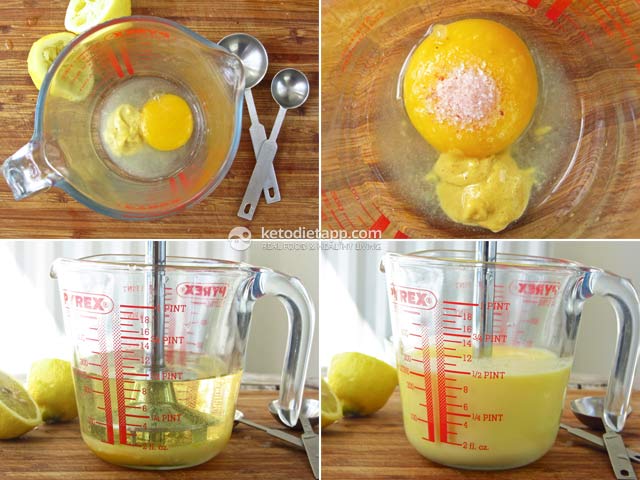
Tips & Substitutions
- If you want the mayonnaise to last several months, add a tablespoon or two of whey (whey is a by-product when making homemade ricotta) or powder from one probiotic capsule (simply open the capsule and combine the powder with the mayo). Cover the mayonnaise and let it sit on a kitchen counter for 8 hours. This is essential in order to activate the enzymes that will keep your mayo fresh. After 8 hours, refrigerate and use within the next 3 months.
- Using raw eggs? If a recipe calls for raw eggs and you are concerned about the potential risk of Salmonella, you can make it safe by using pasteurized eggs. To pasteurize eggs at home, simply pour enough water in a saucepan to cover the eggs. Heat to about 60 °C/ 140 °F. Using a spoon, slowly place the eggs into the saucepan. Keep the eggs in the water for about 3 minutes. This should be enough to pasteurize the eggs and kill any potential bacteria. Let the eggs cool down and store in the fridge for 6-8 weeks.
Hands-on Overall
Serving size 1 tbsp/ 15 ml
Nutritional values (per serving, 1 tbsp/ 15 ml)
Net carbs0.1 grams
Protein0.2 grams
Fat12 grams
Calories108 kcal
Calories from carbs 0%, protein 1%, fat 99%
Total carbs0.1 gramsFiber0 gramsSugars0 gramsSaturated fat1.2 gramsSodium46 mg(2% RDA)Magnesium1 mg(0% RDA)Potassium7 mg(0% EMR)
Ingredients (makes about 215 g/ 7.5 oz)
- 3/4 cup walnut, macadamia or avocado oil, or light-tasting olive oil (180 ml/ 6 fl oz)
- 1 large egg yolk
- 1 tbsp apple cider vinegar or homemade fruit vinegar (15 ml)
- 1 tsp Dijon mustard (you can make your own)
- 1 tbsp lemon juice (15 ml)
- 1/4 tsp salt, or more to taste
- Optional: 1 - 2 tbsp whey or powder from 1 probiotic capsule (see notes in step 8)
Instructions
- Make sure all the ingredients have reached room temperature. Separate the egg white from the egg yolk. You can reserve the egg white for another recipe such as our low-carb bread.

- Place the egg yolk and the Dijon mustard (try homemade mustard) into a bowl. Add 1 teaspoon of vinegar (reserve the other 2 teaspoons for step 6) - that will help the mayo emulsify. Secure the bowl with a piece of cloth or kitchen towel and blend until well combined.
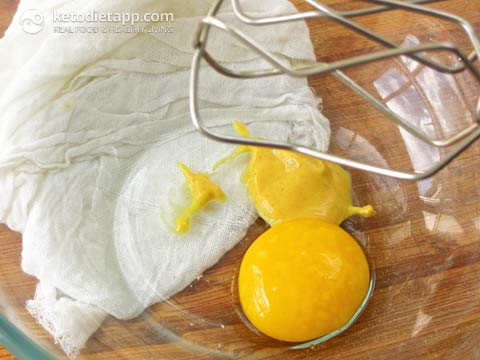
- Use a food processor (or a hand whisk). Turn it on and very slowly start to drizzle in the oil.
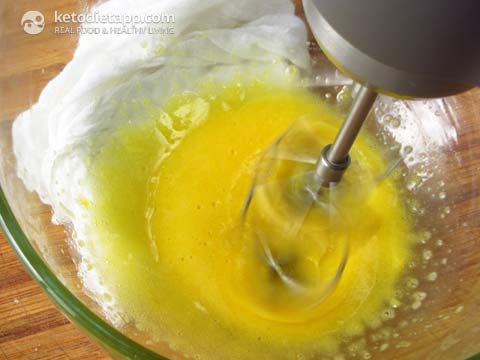
- Using extra virgin olive oil may make the taste of your mayonnaise too strong. Try mild olive oil, avocado, macadamia, sesame, almond or walnut oil and discover what your favourite one is - it won't affect the net carb content.

- Keep pouring the oil until the mixture starts to look more like mayonnaise. Then, a slow steady stream of oil can be added. Keep the food processor on until it gets to a desired thickness. If the mayonnaise is not thick enough, add a bit more oil.
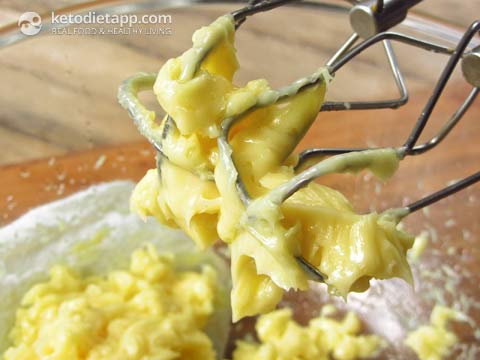
- After you pour all the oil in, add lemon juice, vinegar and season with salt. Add a few drops of stevia (if needed) and mix well. If it's too thick, add a few drops of water.
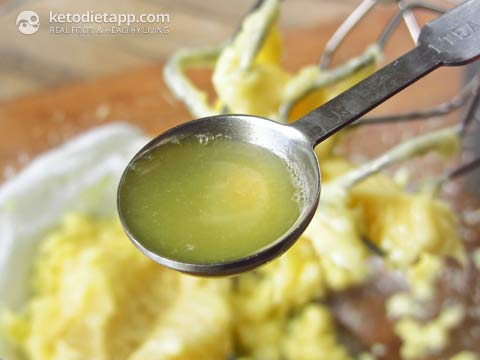
- Mix until well combined. Adding the lemon and vinegar will turn the colour to a light yellow.

- When the mayonnaise is done, put it in a glass container and seal well. You can store it in the fridge for up to a week. This is how the mayo looks like if you use macadamia or walnut oil.

- And this is how the mayo looks using virgin avocado oil.
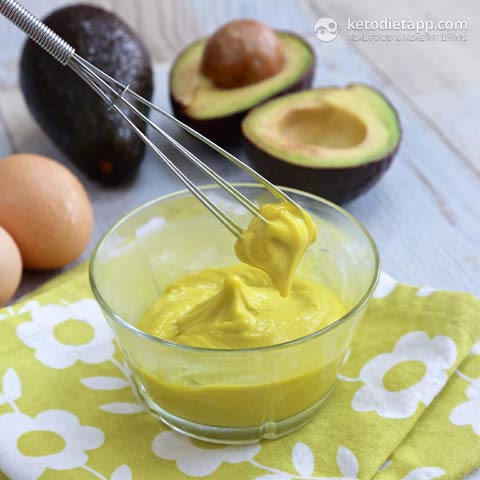
Ingredient nutritional breakdown (per serving, 1 tbsp/ 15 ml)
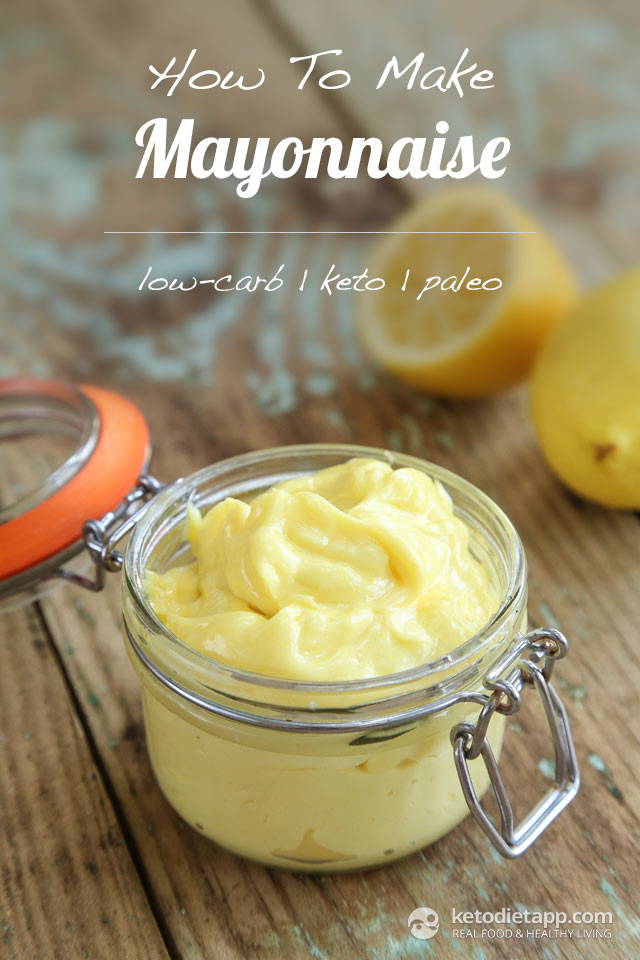 Follow us 148.4k
Follow us 148.4k
Do you like this recipe? Share it with your friends!
Let us know what you think, rate this recipe!
